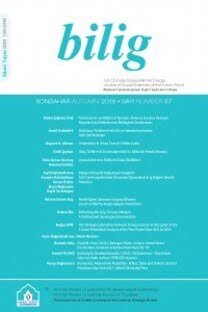One Nation, Many Voices? External Cohesion of the Turkic Council States in the United Nations General Assembly, 1993-2011
One Nation, Many Voices? External Cohesion of the Turkic Council States in the United Nations General Assembly, 1993-2011
Bu makale, CCTS veya Türk Konseyi olarak bilinen Türk Dili Konuşan Ülkeler İşbirliği Konseyi üyelerinin (Azerbaycan, Kazakistan, Kırgızistan ve Türkiye) Birleşmiş Milletler Genel Kurulundaki (UNGA) oylamalarda ne ölçüde uyumlu hareket ettiklerini incelemektedir. 19932011 dönemi Türk Konseyi ülkelerinin Birleşmiş Milletler Genel Kurulu oy yakınlaşması- nın analiz edildiği ve bunun tüm BM üyelerinin ortalamasıyla kıyaslandığı bu makalede, Türk Konseyi ülkelerinin dış politika meseleleriyle ilgili sergiledikleri oy yakınlaşmasının giderek arttığı gözlemlenmiştir. Bu durum söz konusu ülkelerin genel dış politika önceliklerinin birbirine yaklaştığını göstermektedir. Nitekim 2007 yılından bu yana bu ülkelerin oy birlikteli- ği BM ortalamasının üzerinde seyretmektedir. Bunun yanı sı- ra, araştırma Türk devletlerinin Birleşmiş Milletler Genel Kurulunda en çok Orta Doğu ve sömürgecilik konularında birlikte hareket ettiklerini, en düşük birlikteliğin ise nükleer silahsızlanma ve kalkınma meselelerinde görüldüğünü ortaya koymaktadır.
___
- Amanov, Shatlyk (2013). Turkey Turkmenistan Relations: Achievements, Current Issues & Challenges in the 21st Century. Turkeys Relations with the Turkish Republics. Eds. Haydar Çakmak ve Mehmet Seyfettin Erol. Ankara: Barış Kitabevi. 163-188.
- Aral, Berdal (2004). Fifty Years On: Turkeys Voting Orientation at the UN General Assembly, 1948-1997. Middle Eastern Studies 40 (2): 137-160.
- Barromi, Joel and Carlos Feldman (1974). Latin American Voting on Israeli Issues in the U.N. General Assembly, 1947-1968. Jewish Social Studies 36 (2): 142-165.
- Chai, Trong R. (1979). Chinese Policy toward the Third World and the Superpowers in the UN General Assembly 1971-1997: A voting analysis. International Organization 33 (3): 391-403.
- Datta, Monti Narayan (2009). The Decline of Americas Soft Power in the United States. International Studies Perspectives 10: 265-284.
- Dreher, Axel and Jan-Egbert Sturm (2012). Do the IMF and the World Bank influence voting in the UN General Assembly?. Public Choice 151 (1-2): 363-397.
- Graham, Suzanne (2011). South Africas UN General Assembly Voting Record from 2003 to 2008: Comparing India, Brazil and South Africa. Politikon 38 (3): 409-32.
- Hagan, Joe D. (1989). Domestic Political Regime Changes and Third World Voting Realignments in the United Nations, 1846-84. International Organization 43 (3): 505-41.
- Hosli, Madeleine O., Evelyn van Kampen, Frits Meijerink and Katherine Tennis (2010). Voting Cohesion in the United Nations General Assembly: The Case of the European Union. Paper presented at the ECPR Fifth PanEuropean Conference. Porto, Portugal.
- Hurwitz, Leon (1974). The EEC in the United Nations: The Voting Behavior of Eight Countries, 1948-1973. Journal of Common Market Studies 13 (2): 224-243.
- Jakobsson, Ulf (2009). An International Actor Under Pressure: The Impact of the War on Terror and the Fifth Enlargement on EU Voting Cohesion at the UN General Assembly 2000-05. Journal of Common Market Studies 47 (3): 532-54.
- Lida, Keisuke (1988). Third World Solidarity: The Group of 77 in the UN General Assembly. International Organization 42 (2): 375-395.
- (2009). Nakhchivan Agreement. Turkkon.org. Full text available online at http://turkkon.org/Assets/dokuman/03_b_NahcivanBildirisi2009_english 0709_withamendments_9thSummit_20140418_103519.doc (accessed 7 July 2015)
- Ruzaliev, Odil (2006). In Search of Turkic Identity. Turkish Policy Quarterly 5 (4).
- Voeten, Erik; Strezhnev, Anton; Bailey, Michael, 2009, "United Nations General Assembly Voting Data", Harvard Dataverse, V7
- http://hdl.handle.net/1902.1/12379, (accessed 7 July 2015).
- ______, (2010). TURKPA Commission on International Relations, n.d. Recommendation on Basic Aspects and Prospects of TURKPAs International Cooperation. http://www.turk-pa.org/documents/Recommendation_of_commission_on_international_re lations.pdf (accessed 7 July 2015).
- ______, (2010). TURKPA Commission on International Relations, n.d. Report: Basic Aspects and Prospects of TURKPAs International Cooperation. http://www.turkpa.org/documents/1.Report_eng_international_relations.pdf (accessed 7 July 2015).
- Volgy, Thomas J., Derrick V. Frazier and Robert Stewart Ingersoll (2003). Preference Similarities and Group Hegemony: G-7 Voting Cohesion in the UN General Assembly. Journal of International Relations and Development 6 (1): 51-70.
- Weiner, Robert (2002). "Postcommunist Moldovan and Romanian Foreign Policy at the United Nations. Paper presented at the 2002 American Political Science Association Meeting, Boston, MA. 1-35.
- Wills, Adrian (1994). New Zealand in the United Nations General Assembly: A Comparative Survey of Alignment. Working Paper no: 3, Centre for Peace Studies, University of Auckland, New Zealand.
- http://www.disarmsecure.org/New%20Zealand%20Voting%20at%20the %20UNGA.pdf (accessed February 12, 2012).
- Yuvacı, Abdullah and Muhittin Kaplan (2013a). Testing the Axis Shift Claim: An Empirical Analysis of Turkeys Voting Alignment on Important Resolutions in the United Nations General Assembly during the Years 2000- 10. Turkish Studies 14 (2): 212-228.
- Yuvacı, Abdullah and Muhittin Kaplan (2013b). Of East or West? Turkeys United Nations General Assembly Voting Preferences on Arms, NorthSouth Economic Issues and Human Rights. Uluslararası İlişkiler 10 (37): 69-95.
- ISSN: 1301-0549
- Yayın Aralığı: 4
- Başlangıç: 1996
- Yayıncı: Ahmet Yesevi Üniversitesi Mütevelli Heyet Başkanlığı
